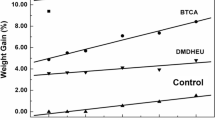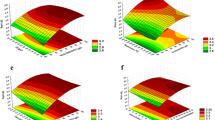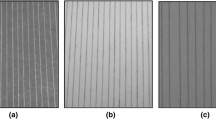Abstract
Durable press finishing is a common process used to impart wrinkle-free properties to cotton fabrics through the crosslinking of cellulose macromolecules. Unfortunately, this process results in a loss of fabric strength and decreases the durability of garments. If the content of crosslinked fibers is reduced in the fabrics, their strength would be retained to a greater extent. In addition, hydrophilic property, permeability, and quality of fabrics could be improved. In the past, researchers primarily focused on the strength of the whole fabric. In this study, single cotton yarns were treated with formaldehyde-based N-methylol finishing agents. Subsequently, they were plied together according to different proportions, and then further cured at a certain temperature. The tensile strength, elongation at break, breaking time, work of rupture and bending rigidity were used to investigate the effects of the treatment on the mechanical properties of cotton yarns. Wrinkle recovery angle was used to evaluate the anti-creasing property of the yarns. The results suggest that when the yarns are plied together in different proportions, their mechanical and anti-creasing properties change with the treatment to which they have been subjected as well as with their blending proportion. Moreover, a reduced anti-creasing yarn proportion decreased the amount of formaldehyde released. This study will guide further development of environmentally friendly anti-crease processing methods.












Similar content being viewed by others
References
Abbott GM (1983) Yarn-bending and the weighted-ring stiffness test. J Text Inst 74:281–286
Banerjee BL, Lahiri A (1969) Utilization of fiber strength in jute yarns. Text Res J 39:1038–1043
Chen D, Yang CQ, Qiu X (2005) Aqueous polymerization of maleic acid and cross-linking of cotton cellulose by poly(maleic acid). Ind Eng Chem Res 44:7921–7927
Kale BM, Wiener J, Militky J, Rwawiire S, Mishra R, Jabbar A (2016) Dyeing and stiffness characteristics of cellulose-coated cotton fabric. Cellulose 23:981–992
Neelakantan P, Patel NC (1975) Measurement of crease-recovery angle of a single filament or yarn. Text Res J 45:264–266
Niu S, Yan H (2015) Novel silicone-based polymer containing active methylene designed for the removal of indoor formaldehyde. J Hazard Mater 287:259–267
Ruppenicker GF, Sawhney APS, Kimmel LB, Price JB (2007) Influence of cotton fiber quality on the strength properties of cotton fabrics treated with flame-resistant and easy-care finishes. AATCC Rev 7:43–48
Schramm C, Rinderer B (2015) Non-formaldehyde, crease-resistant modification of cellulosic material by means of an organotrialkoxysilane and metal alkoxides. Cellulose 22:2811–2824
Shih CY, Huang KS (2002) Kinetic studies of crease-resistant finishing process for cotton fabrics with DMEU/MMEU prepolymer mixture. J Appl Polym Sci 85:509–513
Xia Z, Xu W, Wang X (2012) Improving fiber trapping with a contact surface during the ring twisting of two cotton yarns. Text Res J 82:272–279
Xu W, Li Y (2000) Crosslinking analysis of polycarboxylic acid durable press finishing of cotton fabrics and strength retention improvement. Text Res J 70:588–592
Xu W, Cui W, Li W, Guo W (2001) Two-step durable press treatment of cotton fabric. Color Technol 117:352–355
Xu F, Yang Y, Zhang G, Zhang F, Zhang Y (2015) A self-stiffness finishing for cotton fabric with N-methylmorpholine-N-oxide. Cellulose 22:2837–2844
Yang CQ, Chen D, Guan J, He Q (2010) Cross-linking cotton cellulose by the combination of maleic acid and sodium hypophosphite. 1. Fabric wrinkle resistance. Ind Eng Chem Res 49:8325–8332
Zhou N, Ghosh TK (1998) On-line measurement of fabric-bending behavior: background, need and potential solutions. Int J Cloth Sci Tech 10:143–156
Acknowledgments
We are very grateful for the financial support from the Natural Science Foundation of Hubei Province of China (Project Code 2014CFB753), the National Funds for Distinguished Young Scientists (Project Code 51325306), and the Foundation of Wuhan Textile University (Project Code 143058).
Author information
Authors and Affiliations
Corresponding author
Rights and permissions
About this article
Cite this article
Wang, Y., Cao, G., Xia, L. et al. Effect of anti-creasing component on properties of two-ply cotton yarn. Cellulose 24, 3073–3082 (2017). https://doi.org/10.1007/s10570-017-1304-z
Received:
Accepted:
Published:
Issue Date:
DOI: https://doi.org/10.1007/s10570-017-1304-z




